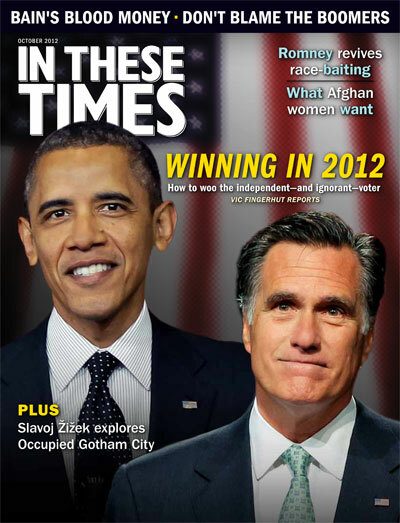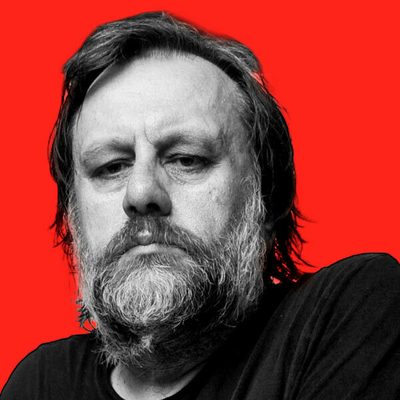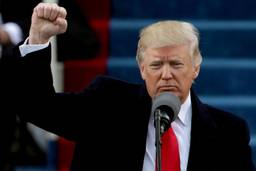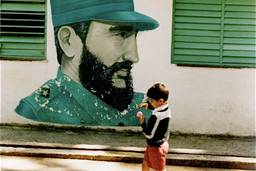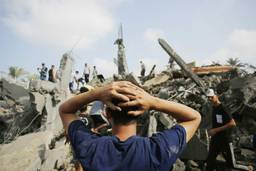Occupy Gotham City
What the Dark Night Rises says about violence, morality and people’s power
Slavoj Žižek
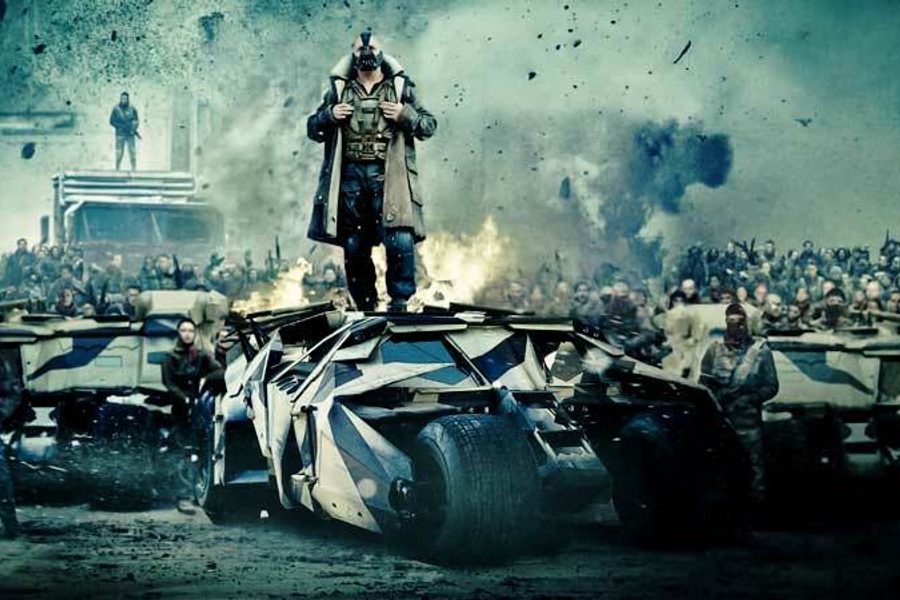
[Ed.: Plot spoilers follow.] Eight years after the events of The Dark Knight—the previous installment of the Batman saga — law and order prevail in Gotham City. Under the extraordinary powers granted by the Dent Act, Commissioner Gordon has nearly eradicated violent and organized crime. He nonetheless feels guilty about letting Batman take the fall for the late Harvey Dent’s crimes and plans to admit to the conspiracy at a public memorial for Dent — but then decides at the last minute that the city is not ready to hear the truth.
No longer active as Batman, Bruce Wayne lives isolated in his manor while his company crumbles — in part because he invested in a clean energy project designed to harness fusion power, then shut it down after learning that the core could be modified to become a nuclear weapon. The beautiful Miranda Tate, a member of the Wayne Enterprises executive board, encourages Wayne to rejoin society and continue his philanthropic works.
Here enters the (first) villain of the film: Bane, a terrorist leader who was a member of the League of Shadows. After Bane’s financial machinations bring Wayne’s company close to bankruptcy, Wayne entrusts Miranda to control his enterprise and also engages in a brief love affair with her. (Her romantic competition is Selina Kyle — Catwoman – who steals from the rich in order to redistribute wealth, but eventually rejoins Wayne and the forces of law and order.) Learning that Bane has gotten hold of his fusion core, Wayne returns as Batman and confronts the villain, who admits that he took over the League of Shadows after Ra’s al Ghul’s death. Crippling Batman in close combat, Bane detains him in a prison from which escape is virtually impossible: Inmates tell Wayne the story of the only person to ever successfully escape, a child driven by necessity and the sheer force of will.
While the imprisoned Wayne recovers from his injuries and retrains himself to be Batman, Bane succeeds in turning Gotham City into an isolated city-state. He lures most of Gotham’s police force underground and traps them there; then he sets off explosions which destroy most of the bridges connecting Gotham City to the mainland; finally he announces that any attempt to leave the city will result in the detonation of Wayne’s fusion core, which has been converted into a bomb.
Here we reach the crucial moment of the film: Bane’s takeover is accompanied by a vast politico-ideological offensive. Bane, who stole a copy of Commissioner Gordon’s intended speech, publicly reveals the cover-up of Dent’s death and releases the prisoners locked up under the Dent Act. Condemning the rich and powerful, he promises to restore the power of the people, calling on the common people to “take your city back.”
The ultimate Occupier
Here is where critics have been quick to pick up on the parallel to Occupy: As Tyler O’Neil writes in the Hillsdale Natural Law Review, Bane reveals himself to be “the ultimate Wall Street Occupier, calling on the 99% to band together and overthrow societal elites.”
Batman is now celebrated as a hero whose sacrifice saved Gotham City, while Wayne is believed to have died in the riots. But Alfred, Wayne’s faithful butler, witnesses Bruce and Selina together alive in a cafe in Florence, while Blake, an honest young policeman who knew about Batman’s identity, inherits the Batcave. In short, as Karthick aptly summarizes, “[Batman] saves the day, emerges unscathed and moves on with a normal life, with someone else to replace his role defending the system.” At Wayne’s (would-be) burial, Alfred reads the last lines from Dickens’s Tale of Two Cities: “It is a far, far better thing that I do, than I have ever done; it is a far, far better rest that I go to than I have ever known.”
Dickens is an inspired choice for a film in which the gap between the rich and the poor is present, but depoliticized. Early in the film, Selina Kyle (Catwoman) whispers to Bruce Wayne (Batman), while they are dancing at an exclusive upper-class gala: “There’s a storm coming, Mr. Wayne. You and your friends better batten down the hatches, because when it hits you’re all gonna wonder how you ever thought you could live so large and leave so little for the rest of us.” Director Christopher Nolan, like every good liberal, is “worried” about this disparity and admits this worry penetrates the film. He told Entertainment Weekly:
What I see in the film that relates to the real world is the idea of dishonesty. The film is all about that coming to a head. … The notion of economic fairness creeps into the film, and the reason is twofold. One, Bruce Wayne is a billionaire. It has to be addressed. … But two, there are a lot of things in life, and economics is one of them, where we have to take a lot of what we’re told on trust, because most of us feel like we don’t have the analytical tools to know what’s going on. … I don’t feel there’s a left or right perspective in the film. What is there is just an honest assessment or honest exploration of the world we live in — things that worry us.
Although viewers know Wayne is mega-rich, they tend to forget where his wealth comes from: arms manufacturing and stock-market speculations. Arms dealer and speculator: This is the true secret beneath the Batman mask. And yet the film establishes Wayne as the generous gentleman-philanthropist, pitting him against the selfish and decadent rich who lack the Wayne family’s sense of noblesse oblige.
And CNN’s Tom Charity rightly noted that the movie defends “the establishment” by presenting a society of “philanthropic billionaires and an incorruptible police” and by exhibiting a distrust of the people taking things into their own hands. Thus, in the words of Slate’s Forrest Wickman, the film “demonstrates both a desire for social justice and a fear of what that can actually look like in the hands of a mob.”
Or, to put it in another way, in Batman Begins, the hero is simply a classic urban vigilante who punishes the criminals that the police cannot. The problem here is that law enforcement relates ambiguously to Batman’s help: While admitting Batman’s efficiency, the police apparatus nonetheless perceives him as a threat to its monopoly on violence and an embarrassing testimony to its own inefficiency. However, Batman’s transgression here is purely formal – acting on behalf of the law without being legitimized to do so. In his actions, he never violates the law.
The Dark Knight changes these coordinates: Batman’s true rival is not Joker, his opponent, but Harvey Dent, his counterpart, the “white knight.” As the aggressive new district attorney, Dent is a kind of official vigilante, whose fanatical battle against crime leads him to kill innocent people and eventually destroy himself. It is as if Dent is the legal order’s response to Batman’s threat: Against Batman’s vigilante struggle, the system generates its own illegal excess. Its own vigilante is much more violent than Batman and directly violates the law. There is thus a poetic justice in the fact that, when Bruce plans to publicly reveal his identity as Batman, Dent jumps in and falsely identifies himself as the masked hero. In return, at the film’s end, Batman takes upon himself the crimes committed by Dent to save the reputation of the popular hero who embodied hope for ordinary people.
Finally, The Dark Knight Rises pushes things even further: Is Bane not Dent brought to a logical extreme? Is Bane not a Dent who has drawn the conclusion that the system itself is unjust — so that in order to effectively fight injustice one has to destroy the system by employing the most brutal of methods?
On the subject of Bane, Karthick raises a perspicuous question: Why is Bane depicted so harshly, while the Joker of the previous film is a more sympathetic villain? (It is not just because Heath Ledger is a more accomplished actor than Tom Hardy.) Karthick’s answer is simple and convincing:
The Joker, calling for anarchy in its purest form… critically underscores the hypocrisies of bourgeois civilization as it exists, [but] his views are unable to translate into mass action. … Bane, on the other hand poses an existential threat to the system of oppression. …His strength is not just his physique but also his ability to command people and mobilize them to achieve a political goal. He represents the vanguard, the organized representative of the oppressed that wages political struggle in their name to bring about structural changes. Such a force, with the greatest subversive potential, the system cannot accommodate. It needs to be eliminated.
Bane is distinguished from the Joker by one thing: his capacity for unconditional love, the very source of his hardness. In a short but touching scene, Bane tells Wayne how, in an act of love in the midst of terrible suffering, he saved the child Talia — and paid a terrible price for his loving act (Bane was beaten within an inch of his life while defending her).
The unity of love and sword
Karthick rightly locates this event into the long tradition, from Christ to Che Guevara, that extols violence as a “work of love.” As the famous lines from Che Guevara’s diary puts it: “Let me say, with the risk of appearing ridiculous, that the true revolutionary is guided by strong feelings of love. It is impossible to think of an authentic revolutionary without this quality.” What we encounter here is not so much the “Christification of Che” but rather a “Cheization of Christ” — the Christ whose scandalous words from the Gospel of Matthew put it this way: “Do not think that I came to bring peace on Earth; I did not come to bring peace, but a sword. For I came to set a man against his father, and a daughter against her mother.” This grim pronouncement seems to be more in harmony with Guevara’s more “problematic” exaltation of revolutionaries as “killing machines”:
Hatred is an element of struggle; relentless hatred of the enemy that impels us over and beyond the natural limitations of man and transforms us into effective, violent, selective and cold killing machines. Our soldiers must be thus; a people without hatred cannot vanquish a brutal enemy.
Guevara is here paraphrasing Christ’s declarations on the unity of love and sword — in both cases, the underlying paradox is that what makes love angelic, what elevates it over mere unstable and pathetic sentimentality, is its cruelty. Violence raises love over and beyond the natural limitations of man and thus transforms it into an unconditional drive. This is why, back to The Dark Knight Rises, the only authentic love in the film is that of Bane, the “terrorist,” in clear contrast to Batman.
Along the same lines, the figure of Ra’s, Talia’s father, deserves a closer look. Ra’s is a mixture of Arab and Oriental features, an agent of virtuous terror fighting to counterbalance the corrupted Western civilization. (Ra’s is played by Liam Neeson, an actor whose screen-persona usually radiates dignified goodness and wisdom — he portrayed Zeus in The Clash of Titans and Qui-Gon Jinn in Star Wars: Episode I—The Phantom Menace).
In Nolan’s Batman trilogy, Ra’s is also the teacher of the young Wayne. In Batman Begins, he finds the young Wayne in a Chinese prison; introducing himself as “Henri Ducard,” he offers the boy a “path.” After Wayne is freed, he climbs to the home of the League of Shadows, where Ra’s is waiting but presenting himself as a servant.
At the end of a long and painful training, Ra’s explains that Bruce must do what is necessary to fight evil, while revealing that he has trained Bruce with the intention of him leading the League to destroy Gotham City, which Ra’s and his followers believe has become hopelessly corrupt. Ra’s is thus not a simple embodiment of Evil: He stands for the combination of virtue and terror, for the disciplined egalitarian fighting a corrupted empire, and thus belongs to the line that stretches (in recent fiction) from Paul Atreides in Dune to Leonidas in 300. And it is crucial that Wayne is his disciple: Wayne was formed as Batman by him.
The immanent center
